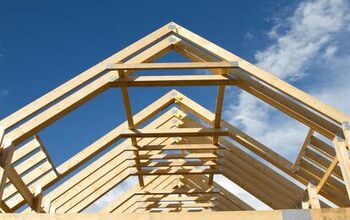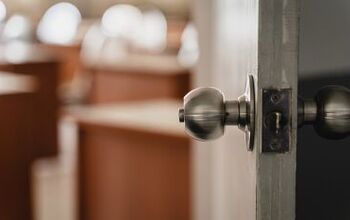Stick Framing Vs. Trusses: What Are The Major Differences?

The roof over your head keeps your family and property safe. A good roof also enhances the curb appeal of your home and increases its value. When you build a house, the architect may talk about using stick framing and trusses. Each option has advantages and disadvantages.
Stick framing is when the frame is built onsite. Trusses are frames that are built offsite. Stick framing is good for remote job sites and projects that may need to be modified during construction. Trusses are more affordable and easier to install. Trusses require lead time and cannot be modified after the trusses are delivered.
Let’s look at how to build a roof and then compare stick framing versus trusses. We will also discuss the various styles and applications of trusses.
Do You Need to Hire a Framing Contractor?
Get free, zero-commitment quotes from pro contractors near you.

How to Frame a Roof
If you’ve ever seen a roof being built, the process seems quite complicated. We’ll use a roof with a simple pitched design to understand the basics. Framing a roof begins with a foundation of horizontal joists. Rafters are connected to the joists at one end and a single ridge beam at the other end. The angle of the rafters determines the pitch of the roof, and the ridge beam is the peak of the roof. When the roof is completely framed, it is covered with plywood and finishing materials, such as shingles.
What is Stick Framing?
For stick framing, the raw materials are delivered to the work site. A team of builders construct the entire roof on site.
Pros of Stick Framing
There are situations in which stick framing is the best option for building a roof.
- Remote job sites where transportation options are limited
- Custom roofs that may need changes during construction
- No lead time needed because all the work is done onsite
Cons of Stick Framing
Stick framing may not always be the most ideal or viable option.
- More expensive than trusses due to the labor costs
- Weather conditions stop work on the roof
- Damage to raw materials from the elements
- Risk of theft while the raw materials sit at the job site
- Imperfections are more likely because the pieces of lumber are being cut at the job site
Cost of Stick Framing
Stick framing a roof for your house costs between $7 and $16 per square foot. If you change the plans during construction, need to replace materials, or extend the project timeline, expect to pay more.
What are Trusses?
Trusses are pre-fabricated sections of the roof that are built off-site. The trusses are then delivered to the job site, and installed on the roof.
Pros of Trusses
Trusses offer many advantages over stick framing.
- Installed on the same day as delivery
- No raw materials on the job site
- More affordable than stick framing – up to 30% less
- Machine cut for exact measurements
- Adverse weather only causes slight delays in installing the roof
- Perfect for open plan homes because the trusses don’t rest on interior walls
Cons of Trusses
There are some downsides to trusses that you should consider.
- Limited transportation options to the job site
- Must be installed with a crane
- Lead time is needed to build the trusses before delivery
- No modifications to the original plan
- May limit the interior space for attics and vaulted ceilings
Cost of Trusses
Expect to pay $35 and $150 per truss for the raw materials. More complex trusses cost up to $400 per piece. Labor costs average $20 to $75 per hour, and you need to account for the pre-fabrication and installation.
Types of Trusses
You can use trusses on almost any type of roof, including gable, skillion, hip, and gambrel. Builders use various designs for trusses to build reliable roofs that stand up to the elements.
King Post Truss
A king post truss starts with a triangular design with a joist, two rafters, and a vertical post. Two additional pieces of lumber (webbing chords) are installed at angles from the center of the bottom joist to about 2/3 of the way up each rafter. King post trusses are the most common technique and used for garages and additions.
Queen Post Truss
A queen post truss also begins as a triangle. The vertical post goes down about 1/3 of the way between the peak and joist. A square frame is built inside the triangle and reinforced with small pieces of lumber at the top two corners. Queen post trusses are used for additions and home construction.
Fink Truss
A fin truss is the second technique that is used for home construction. A zigzag pattern is created inside the triangle with four pieces of lumber that are attached to the joist and rafters.
Attic Truss
An attic truss is a more complex style of the queen post truss. A square is constructed inside the triangle, and small pieces of lumber are installed at each corner of the triangle. Attic trusses are used to create lofts or attic spaces.
Scissor Truss
If you want vaulted ceilings and like the advantages of using trusses for construction, scissor trusses are perfect for the job. Unlike other truss designs, a scissor truss does not begin with a triangle. The peak of the roof is built with two sets of rafters. The first set is angled to match the pitch of the roof. The second set of rafters is built just below the first and at a slightly smaller angle. Small pieces of lumber are installed between the sets of rafters for stability.
Gable Truss
Gable trusses have the simplest design. A single joist and two rafters are used to build the outer triangle. A series of vertical posts are installed inside the triangle.
How to Replace Roof Trusses with Stick Framing
Adding a loft or attic space are just two reasons why you may want to replace your roof trusses with stick framing. The trusses need to be cut from the roof, so use temporary load bearers. The job of removing trusses is easier when you have a crane onsite. Dropping a truss causes a great deal of damage to your home and property. Before your build the new roof with stick framing, check that the floor is strong enough for daily use.
Related Questions
What’s the difference between rafters and trusses?
Rafters are the two main beams that hold up a roof. Trusses are pre-fabricated sections of lumber that frame your roof.
What is stick framing with green lumber?
Green lumber is wood that has not been dried or treated. The wood is taken directly from a felled tree and immediately used for the construction. Stick framing with green lumber is typically used for building cabins in remote locations.
Why are steel trusses used?
Steel trusses are ideal for structures that are subjected to extremely high winds, such as hurricanes. Steel trusses are used for commercial and residential construction.
Do You Need to Hire a Framing Contractor?
Get free, zero-commitment quotes from pro contractors near you.

A Quick Review
Stick framing and trusses are two ways to build the roof of your home. Each of these options work well for most roof styles, including custom designs. There are six basic styles of trusses, and each style is designed to maximize the integrity of the roof and aesthetics of your home.
For stick framing, the raw materials are delivered to the job site and assembled. Trusses are pre-fabricated sections of a roof frame that are delivered to a job site.
Stick framing is best for construction projects in remote locations where transportation is limited. Trusses are best for keeping projects within budget and timelines.
You can replace trusses with stick framing if you want more interior space, such as vaulted ceilings, attic space, or a loft. The trusses are cut away from the frame of the house. Use a crane to remove the trusses. Stick framing is then installed, and the roof is covered with plywood and shingles or another type of roofing material.

Jennifer L. Eggerton loves being hands-on, whether it's with a home DIY project, making repairs, re-decorating a room, or keeping life organized. She enjoys helping people by sharing her knowledge, insights, and experiences, as well as her lessons learned. In addition to her work as a writer, Jennifer is a Jeep® overlander, self-published author, and nature photographer who loves being outdoors.
More by Jennifer Eggerton



























